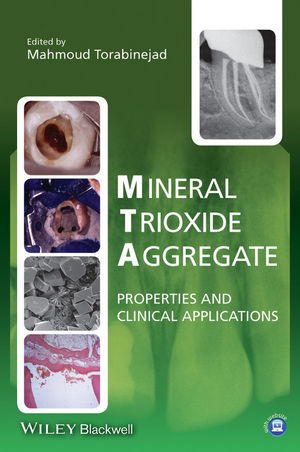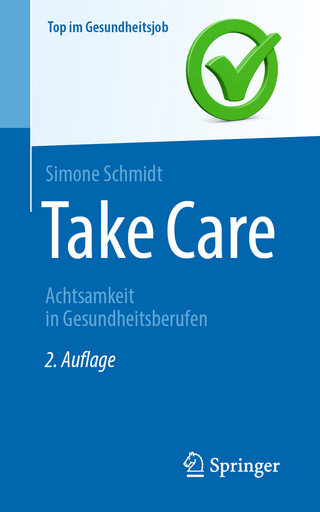
Mineral Trioxide Aggregate
Wiley-Blackwell (Verlag)
978-1-118-40128-6 (ISBN)
Mineral trioxide aggregate (MTA) was developed more than 20 years ago to seal the pathways of communication of the root canal system. It’s currently the preferred material used by endodontists because of its superior properties such as its seal and biocompatibility that significantly improves outcomes of endodontic treatments.
Dr. Torabinejad, who was the principle investigator of the dental applications of MTA, and leading authorities on this subject provide a clinically focused reference detailing the properties and uses of MTA, including vital pulp therapy (pulp capping, pulpotomy), apexification, pulp regeneration, repair of root perforations, root end filling and root canal filling. Line illustrations and clinical photographs show proper technique. An accompanying website features photographs and video presentations for selected procedures using MTA.
Mineral Trioxide Aggregate: Properties and Clinical Applications is an ideal book for dental students and endodontic residents learning procedures for the first time as well as practicing dentists and endodontists who would like to improve outcomes of endodontic treatments.
Mahmoud Torabinejad, DMD, MSD, PhD, is Professor of Endodontics and Director of the Advanced Specialty Education Program in Endodontics at Loma Linda University School of Dentistry in Loma Linda, California. As a researcher and international lecturer on dental and endodontic issues and procedures, Dr. Torabinejad has made over 200 national and international presentations in more than 40 countries. In addition to co-authoring three textbooks in nonsurgical and surgical endodontics, he has authored more than 300 publications on various endodontic and dental topics. As a researcher, he is the top -cited author in endodontic journals, with authorship in 16 articles of the top 100 list. Dr. Torabinejad was the principle investigator in the applications of MTA in dental procedures.
Contributors xv
Preface xvii
1 Pulp and Periradicular Pathways, Pathosis, and Closure 1
Mahmoud Torabinejad
Pulp and Periradicular Pathways 2
Natural Pathways 2
Apical foramen 2
Lateral canals 4
Dentinal tubules 4
Pathological and Iatrogenic Pathways 5
Dental caries 5
Role of microorganisms 6
Root perforations 7
Root perforations during access preparation 7
Root perforations during cleaning and shaping 8
Root perforations during post space preparations 10
Vertical fracture 10
Periradicular Pathosis 11
Inflammatory process of periradicular lesions 11
Materials to Seal the Pathways to the Root Canal System and the Periodontium 13
References 15
2 Chemical Properties of MTA 17
David W. Berzins
Introduction 17
MTA Composition 19
Portland cement 19
Role of bismuth oxide and gypsum 20
MTA powder morphology 21
Trace elements and compounds 23
Setting Reactions 23
Setting time 26
Maturation 26
Factors that affect setting: additives and accelerants 26
Effect of water and moisture 27
Interaction with environment 27
Development of Reaction Zones 28
References 31
3 Physical Properties of MTA 37
Ricardo Caicedo and Lawrence Gettleman
Introduction 38
pH 38
Solubility 40
Setting Expansion 45
Radiopacity 46
Various Types of Strength 49
Compressive strength 49
Flexural strength 54
Shear strength 55
Push-out strength 56
Shear bond strength 56
Overview 57
Microhardness 59
Color and Aesthetics 61
Physicochemical Properties 62
Acknowledgment 66
References 66
4 MTA in Vital Pulp Therapy 71
Till Dammaschke, Joe H. Camp, and George Bogen
Introduction 72
Advantages 74
Pulp Responses to Capping Materials 74
Direct Pulp Capping with Calcium Hydroxide 75
Mineral Trioxide Aggregate 77
Physiochemical properties 77
Mode of action in pulp capping and pulpotomy 80
Comparison with calcium hydroxide 83
Pulpotomy in Primary Teeth 85
MTA Pulpotomy 86
Primary teeth 86
Immature permanent teeth 88
Symptomatic permanent teeth 90
Pulp Capping in Teeth Diagnosed with Reversible Pulpitis 94
Treatment Considerations 96
Disadvantages 98
Summary 99
Acknowledgment 99
References 100
5 Management of Teeth with Necrotic Pulps and Open Apices 111
Shahrokh Shabahang and David E. Witherspoon
Diagnosis in Immature Teeth 111
History of Treating Immature Teeth 114
Infection Control in Immature Teeth 116
Apexification 118
Calcium Hydroxide Apexification Therapy: Outcomes 119
Non-Vital Pulp Therapy 121
Root-end closure via the use of apical barriers 121
Mineral trioxide aggregate apical plug 122
Technical placement 124
Outcomes 124
References 131
6 Regenerative Endodontics (Revitalization/Revascularization) 141
Mahmoud Torabinejad, Robert P. Corr, and George T.-J. Huang
Introduction 142
Revascularization after Replantation and Autotransplantation 143
Revitalization of Nonvital-Infected Teeth in Animals 145
Clinical Evidence for Revitalization in Nonvital-Infected Teeth in Humans 152
Potential Role of Stem Cells in Canal Tissue Generation and Regeneration 160
Role of DPSCs and SCAP in revitalization and regenerative endodontic treatments 161
Scaffolds and growth factors for regenerative endodontics (Revitalization) 164
Clinical Procedures for Pulp Revitalization 168
First appointment 168
Second appointment 168
Clinical and radiographic follow-up 170
References 170
7 Use of MTA as Root Perforation Repair 177
Mahmoud Torabinejad and Ron Lemon
Introduction 178
Types of Perforation Defects 182
Access preparation-related perforations 182
Cleaning and shaping related (“strip”) perforations 184
Resorption-related perforations (internal/external) 184
Factors Influencing Prognosis for Repair 187
Size of perforation 187
Location of the perforation 187
Pulp Chamber Perforations 189
Etiologies 189
Prevention 189
Recognition and treatment of pulp chamber perforations 189
Lateral surface repairs 190
Furcation repairs 190
Root Perforations During Cleaning and Shaping 191
Coronal root perforations 191
Causes, indicators and prevention 191
Treatment 193
Prognosis 193
Lateral perforations 194
Causes and indicators 194
Treatment of mid-root perforation 194
Prognosis 195
Apical perforations 195
Causes and indicators 196
Treatment 197
Prognosis 197
Root Perforation during Post Space preparation 197
Causes, indicators and prevention 197
Treatment 197
Prognosis 199
Time elapsed since perforation 199
Techniques for Internal Repair Using MTA 199
Method 199
Summary 202
References 203
8 MTA Root Canal Obturation 207
George Bogen, Ingrid Lawaty, and Nicholas Chandler
Introduction 208
Charactertics/Properties 210
Mechanisms of action in obturation 210
Particle size 211
Hydration products and pH 211
Formation of interstitial layer 212
Fracture resistance 212
Sealing ability and setting expansion 213
Applications/Uses 214
Conventional obturation 214
Retreatment 216
Obturation prior to surgery 219
Obturation with perforation repair 219
Apexification using MTA obturation 222
Obturation for dental anomalies 225
Obturation Techniques 225
Standard compaction technique 226
Lawaty technique 229
Auger technique 231
Restorative Considerations 234
Drawbacks 234
Sealers 235
Zinc oxide–eugenol sealers 236
Calcium hydroxide sealers 236
Epoxy resin-based sealers 236
Glass ionomer sealers 237
Silicone-based sealers 237
Monoblock sealer systems 237
Calcium silicate-based sealers 237
Summary 238
References 239
9 Root-End Fillings Using MTA 251
Seung-Ho Baek and Su-Jung Shin
Introduction of Root-End Filling Materials 252
Purpose of root-end fillings 252
History of Root-End Filling Materials 253
Amalgam 254
ZOE-based materials: IRM and SuperEBA 254
Resin-based materials: Retroplast and Geristore 256
Mineral trioxide aggregate (MTA) 256
Gray vs. White MTA 257
New types of MTA-like cements 257
Requirements of Ideal Root-End Filling Materials 258
Advantages and disadvantages of MTA as a root-end filling material 258
Advantages of MTA 258
Disadvantages of MTA 259
MTA as a Root-End Filling Material 260
Cytotoxicity and biocompatibility 260
Bioactivity 263
Sealability 264
Antibacterial effect 265
Clinical Applications of MTA 265
Retropreparation and root-end filling 265
Cavity preparation for MTA root-end filling 265
Mixing procedure 266
Methods for placement of MTA 266
Clinical outcomes 268
Conclusion 272
References 275
10 Calcium Silicate–Based Cements 281
Masoud Parirokh and Mahmoud Torabinejad
Introduction 284
Portland Cement (PC) 285
Chemical composition 285
Physical properties 286
Antibacterial activity 287
Sealing ability 288
Biocompatibility 288
Cell culture studies 288
Subcutaneous implantation 288
In vivo investigations 289
Clinical applications 289
Limitations 289
Angelus MTA 291
Chemical composition 291
Physical properties 292
Antibacterial activity 293
Sealing ability 293
Biocompatibility properties 293
Cell structure studies 293
Subcutaneous implantation 294
Intraosseous implantation 294
In vivo investigations 294
Clinical applications 295
Bioaggregate (BA) 295
Chemical composition 295
Physical properties 296
Antibacterial activity 296
Sealing ability 296
Biocompatibility 296
Cell culture studies 296
Biodentine (BD) 297
Chemical composition 297
Physical properties 297
Biocompatibility and clinical applications 297
iRoot 298
Chemical composition 298
Physical properties 298
Biocompatibility 299
Calcium Enriched Mixture (CEM) Cement 299
Chemical composition 299
Physical properties 300
Antibacterial activities 301
Sealing ability 301
Biocompatibility 301
Cell culture studies 301
Skin test and subcutaneous implantation 302
Intraosseous implantation 302
In vivo investigations 302
Clinical investigations 303
MTA Fillapex 304
Chemical composition 304
Physical properties 304
Antibacterial activities 305
Biocompatibility 306
Cell culture studies 306
Subcutaneous implantation 306
Endo-CPM 306
Chemical composition 307
Physical properties 307
Antibacterial activity 307
Sealing ability 307
Biocompatibility 307
Cell culture studies 307
Subcutaneous implantation 307
In vivo investigations 308
Cimento Endodontico Rapido (CER) 308
Chemical composition 308
Physical properties 308
Biocompatibility 308
Subcutaneous implantation 308
Endosequence 309
Chemical composition 309
Physical properties 309
Antibacterial activities 310
Sealing ability 310
Biocompatibility 310
Cell culture studies 310
EndoSequence BC Sealer 310
Chemical composition 311
Physical properties 311
Biocompatibility 311
ProRoot Endo Sealer 311
Chemical composition 311
Physical properties 312
MTA Plus 312
Chemical composition 312
Physical properties 312
Ortho MTA 313
Chemical composition 313
Biocompatibility 313
Cell culture studies 313
MTA Bio 313
Chemical composition 313
Physical properties 314
Biocompatibility 314
Cell culture studies 314
Subcutaneous implantation 315
MTA Sealer (MTAS) 315
Chemical compositions and physical properties 315
Fluoride-Doped MTA Cement 315
Chemical composition 315
Physical properties 316
Sealing ability 316
Capasio 316
Chemical composition and physical properties 316
Generex A 317
Chemical composition and physical properties 317
Biocompatibility 317
Cell culture study 317
Ceramicrete-D 317
Chemical composition and physical properties 317
Nano-Modified MTA (NMTA) 318
Chemical composition and physical properties 318
Light-Cured MTA 318
Chemical composition and physical properties 318
Biocompatibility 319
Subcutaneous implantation 319
Calcium Silicate (CS) 319
Chemical composition and physical properties 319
Endocem 320
Chemical composition and physical properties 320
Biocompatibility 320
Cell culture study 320
Other Experimental MTA Lookalike Mixtures 320
Conclusion 320
References 321
Index 333
| Erscheint lt. Verlag | 25.8.2014 |
|---|---|
| Verlagsort | Hoboken |
| Sprache | englisch |
| Maße | 178 x 252 mm |
| Gewicht | 853 g |
| Themenwelt | Medizin / Pharmazie ► Allgemeines / Lexika |
| Medizin / Pharmazie ► Zahnmedizin | |
| ISBN-10 | 1-118-40128-X / 111840128X |
| ISBN-13 | 978-1-118-40128-6 / 9781118401286 |
| Zustand | Neuware |
| Haben Sie eine Frage zum Produkt? |
aus dem Bereich


